 | | | Switch to: Europe, USA, New Zealand, Antarctica Credit: NOAA/Ovation  Planetary K-index Planetary K-index
Now: Kp= 1.00 quiet
24-hr max: Kp= 1.33 quiet
explanation | more data
Interplanetary Mag. Field
Btotal: 6.25 nT
Bz: 1.96 nT north
more data: ACE, DSCOVR
Updated: Today at 1147 UT  Coronal Holes: 29 May 23 Coronal Holes: 29 May 23 
There are no significant equatorial coronal holes on the Earthside of the sun. Credit: SDO/AIA  Noctilucent Clouds Noctilucent Clouds
Bad news: NASA's AIM spacecraft, which monitors noctilucent clouds, may be dead due to problems with an onboard battery. Mission controllers have not yet given up all hope, so stay tuned. Switch view:Ross Ice Shelf, Antarctic Peninsula, East Antarctica, Polar Updated May29  SPACE WEATHER
NOAA Forecasts | | Updated at: 2023 May 29 2200 UTC FLARE | 0-24 hr | 24-48 hr | CLASS M | 40 % | 40 % | CLASS X | 10 % | 10 % |  Geomagnetic Storms: Geomagnetic Storms:
Probabilities for significant disturbances in Earth's magnetic field are given for three activity levels: active, minor storm, severe storm Updated at: 2023 May 29 2200 UTC Mid-latitudes | 0-24 hr | 24-48 hr | ACTIVE | 20 % | 10 % | MINOR | 05 % | 01 % | SEVERE | 01 % | 01 % | High latitudes | 0-24 hr | 24-48 hr | ACTIVE | 15 % | 15 % | MINOR | 20 % | 25 % | SEVERE | 25 % | 20 % | | | |  | | | | | | | | | | | Text created by ChatGPT and other Large Language Models is spreading rapidly across the Internet. It's well-written, artificial, frequently inaccurate. If you find a mistake on Spaceweather.com, rest assured it was made by a real human being. This is an AI Free Zone! | | | MANHATTANHENGE TODAY: Twice a year at sunset, the concrete canyons of New York City turn into an urban simulacrum of an ancient astronomical observatory. Instead of Stonehenge, New York has Manhattanhenge. Today is one of those days. On Monday, May 29th at 8:13 pm ET, the setting sun will beam directly down Manhattan's east-west streets. Got a picture? Submit it here. COMPLEX SUN HALO: You're not supposed to look straight at the sun, but... "I'm so glad I did," says R. J. Cobain of Conlig, Northern Ireland. "I was dumbfounded yesterday when I happened to look up at the sky." The sun was surrounded by a lacy network of halos and arcs: 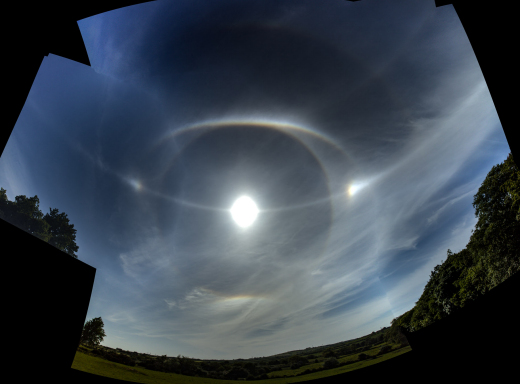
"It's by far the best display of atmospheric optics I have ever seen," he says. "I was shaking as I took as many photos as I could. There was a complete parhelic circle, a circumscribed halo, a supralateral arc, a 22-degree halo, a pair of sundogs, and possibly a Wegener arc." What caused this? Ice crystals. Freezing-cold cirrus clouds drifted in front of the sun, catching its rays and bending them into exotic forms. Complex halos like this require not just one type of ice crystal, but many, with gem-like perfection and unusually precise crystal-to-crystal alignment. Clouds that contain such an ensemble of ice crystals are very rare. more images: from Alan Fitzsimmons of Belfast, Northern Ireland Realtime Space Weather Photo Gallery
Free: Spaceweather.com Newsletter BIG EARTH-FACING SUNSPOT: Growing sunspot AR3315 is now 10 times wider than Earth. Philippe Tosi photographed the behemoth from his backyard observatory in Nîmes, France: 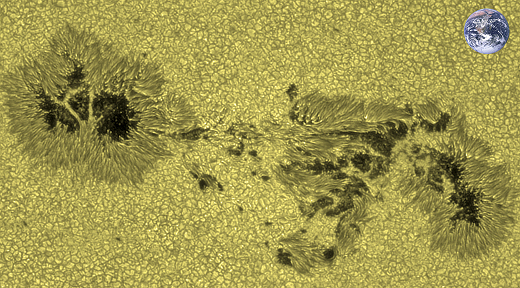
It's big and dangerous. The sunspot has a 'beta-gamma-delta' magnetic field that harbors energy for strong explosions. NOAA forecasters estimate a 55% chance of M-class solar flares and a 10% chance of X-flares on May 29th. Any eruptions will be geoeffective because the sunspot is almost directly facing Earth. Solar flare alerts: SMS Text more images: from Michael Schmidt of Austria; from Pepe Manteca of Begues, Catalunya, Spain; from Alexander Golitschek of Darmstadt, Germany; from Marco Vaccari of Venice, Italy; Realtime Space Weather Photo Gallery
Free: Spaceweather.com Newsletter FOR FATHER'S DAY--THE MR. SPOCK COFFEE CUP: Father's Day is coming. Give dad the gift of coffee in a Mr. Spock Cup. It has pointy ears, holds 20 oz. of brew, and comes from the edge of space. The students of Earth to Sky Calculus flew this cup to the stratosphere onboard a cosmic ray research balloon:
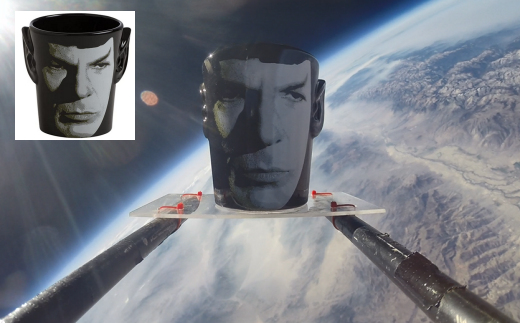
You can have it for $99.95. The students are selling Spock cups to support their cosmic ray ballooning program. Each one comes with greeting card showing the heavy-duty ceramic cup in flight and telling the story of its journey to the stratosphere and back again. Far Out Gifts: Earth to Sky Store
All sales support hands-on STEM education
Realtime Aurora Photo Gallery
Free: Spaceweather.com Newsletter Every night, a network of NASA all-sky cameras scans the skies above the United States for meteoritic fireballs. Automated software maintained by NASA's Meteoroid Environment Office calculates their orbits, velocity, penetration depth in Earth's atmosphere and many other characteristics. Daily results are presented here on Spaceweather.com. On May 27, 2023, the network reported 6 fireballs.
(6 sporadics) 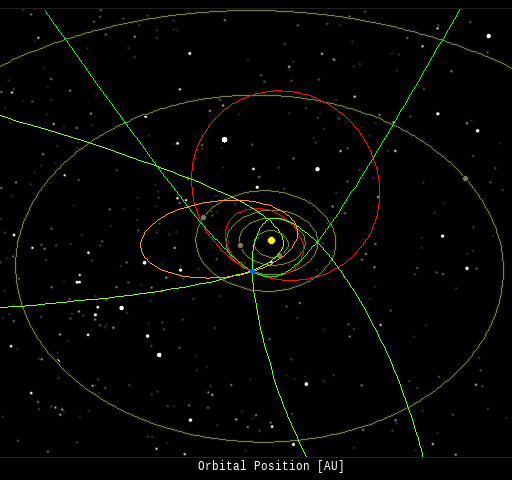 In this diagram of the inner solar system, all of the fireball orbits intersect at a single point--Earth. The orbits are color-coded by velocity, from slow (red) to fast (blue). [Larger image] [movies] Potentially Hazardous Asteroids ( PHAs) are space rocks larger than approximately 100m that can come closer to Earth than 0.05 AU. None of the known PHAs is on a collision course with our planet, although astronomers are finding new ones all the time. On May 29, 2023 there were 2335 potentially hazardous asteroids.
 | Recent & Upcoming Earth-asteroid encounters: | Asteroid | Date(UT) | Miss Distance | Velocity (km/s) | Diameter (m) | | 2023 KF1 | 2023-May-24 | 4.4 LD | 12 | 23 | | 2023 KG4 | 2023-May-24 | 2.2 LD | 12.7 | 19 | | 2023 JC4 | 2023-May-24 | 17.7 LD | 4.1 | 30 | | 2023 CL3 | 2023-May-24 | 18.9 LD | 7.3 | 117 | | 2023 KF4 | 2023-May-24 | 3.5 LD | 4.7 | 7 | | 2023 JP2 | 2023-May-25 | 11.5 LD | 20.5 | 88 | | 2023 KA2 | 2023-May-25 | 1.1 LD | 16 | 11 | | 2023 JR4 | 2023-May-25 | 4.1 LD | 9.4 | 16 | | 2023 KQ1 | 2023-May-25 | 14.2 LD | 18 | 33 | | 2023 KT3 | 2023-May-25 | 2.9 LD | 12.5 | 65 | | 2023 KY3 | 2023-May-25 | 6.9 LD | 8.1 | 22 | | 2023 KZ | 2023-May-26 | 8.9 LD | 4.4 | 13 | | 2023 KB2 | 2023-May-26 | 11.9 LD | 7.3 | 23 | | 2023 KX | 2023-May-26 | 16 LD | 15.9 | 30 | | 2023 KC3 | 2023-May-26 | 11.6 LD | 10.5 | 19 | | 2023 KF | 2023-May-26 | 17.9 LD | 8 | 42 | | 2023 KK4 | 2023-May-27 | 0.9 LD | 17.9 | 11 | | 2023 JE2 | 2023-May-27 | 19.7 LD | 11.4 | 35 | | 2023 KL1 | 2023-May-27 | 9.1 LD | 6.2 | 18 | | 2023 KW3 | 2023-May-28 | 3.5 LD | 7 | 9 | | 2023 KX3 | 2023-May-28 | 2.6 LD | 3.1 | 24 | | 2023 KU2 | 2023-May-28 | 2.8 LD | 14.7 | 13 | | 2023 KV2 | 2023-May-28 | 6.7 LD | 9.3 | 23 | | 2023 JZ3 | 2023-May-28 | 14.2 LD | 4.1 | 25 | | 2023 KV3 | 2023-May-29 | 1.2 LD | 11.1 | 8 | | 2021 KO2 | 2023-May-29 | 15.8 LD | 13.9 | 9 | | 2023 JZ4 | 2023-May-29 | 6 LD | 16.1 | 34 | | 2023 KT1 | 2023-May-30 | 10 LD | 7.8 | 23 | | 2012 KP24 | 2023-May-31 | 10.3 LD | 12.4 | 19 | | 2023 JM1 | 2023-Jun-01 | 10.1 LD | 5.1 | 23 | | 2023 KZ2 | 2023-Jun-02 | 12.4 LD | 9.3 | 20 | | 2023 KS2 | 2023-Jun-02 | 10.3 LD | 10.3 | 22 | | 2023 JE5 | 2023-Jun-04 | 17.6 LD | 8 | 35 | | 2023 JR2 | 2023-Jun-04 | 17 LD | 7.6 | 39 | | 2023 HO18 | 2023-Jun-04 | 1.2 LD | 4.7 | 33 | | 2023 KW2 | 2023-Jun-06 | 11.8 LD | 10.1 | 62 | | 2018 KR | 2023-Jun-07 | 6.5 LD | 4.9 | 19 | | 2017 UJ2 | 2023-Jun-07 | 5.3 LD | 5.6 | 2 | | 2023 JB3 | 2023-Jun-09 | 14.1 LD | 7 | 50 | | 488453 | 2023-Jun-12 | 8.3 LD | 21.5 | 495 | | 2022 WN4 | 2023-Jun-13 | 10.8 LD | 15.1 | 158 | | 2020 DB5 | 2023-Jun-15 | 11.3 LD | 9.5 | 506 | | 2023 HL | 2023-Jun-17 | 13.5 LD | 1 | 15 | | 2016 LK49 | 2023-Jun-19 | 17.4 LD | 19.4 | 22 | | 2023 HF1 | 2023-Jun-21 | 12.5 LD | 4.4 | 59 | | 467336 | 2023-Jun-24 | 17.4 LD | 7.1 | 269 | | 2008 LG2 | 2023-Jun-24 | 10.5 LD | 5.6 | 32 | | 2013 WV44 | 2023-Jun-28 | 9.1 LD | 11.8 | 95 | | 2022 MM1 | 2023-Jun-29 | 9.5 LD | 9.8 | 41 | | 2020 NC | 2023-Jul-02 | 13.9 LD | 7.7 | 123 | | 2023 HO6 | 2023-Jul-05 | 5.3 LD | 7.8 | 243 | | 2019 LH5 | 2023-Jul-07 | 14.9 LD | 21.6 | 281 | | 2018 NW | 2023-Jul-10 | 18 LD | 21.8 | 10 | | 2018 UY | 2023-Jul-12 | 7.4 LD | 16.4 | 243 | | 2020 UQ3 | 2023-Jul-18 | 3.2 LD | 9.3 | 59 | | 2022 GX2 | 2023-Jul-20 | 11.9 LD | 9.4 | 5 | | 2020 OM | 2023-Jul-20 | 8.5 LD | 9.5 | 14 | | 2015 MA54 | 2023-Jul-24 | 16.6 LD | 9.2 | 31 | | 2018 BG5 | 2023-Jul-27 | 10.7 LD | 8.4 | 56 | Notes: LD means "Lunar Distance." 1 LD = 384,401 km, the distance between Earth and the Moon. 1 LD also equals 0.00256 AU. | | Cosmic Rays in the Atmosphere | SPACE WEATHER BALLOON DATA: Almost once a week, Spaceweather.com and the students of Earth to Sky Calculus fly space weather balloons to the stratosphere over California. These balloons are equipped with sensors that detect secondary cosmic rays, a form of radiation from space that can penetrate all the way down to Earth's surface. Our monitoring program has been underway without interruption for 7 years, resulting in a unique dataset of in situ atmospheric measurements. Latest results (July 2022): Atmospheric radiation is decreasing in 2022. Our latest measurements in July 2022 registered a 6-year low: 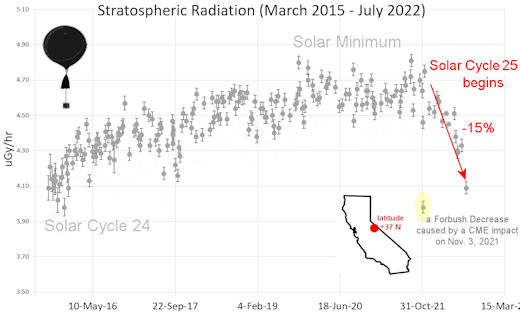
What's going on? Ironically, the radiation drop is caused by increasing solar activity. Solar Cycle 25 has roared to life faster than forecasters expected. The sun's strengthening and increasingly tangled magnetic field repels cosmic rays from deep space. In addition, solar coronal mass ejections (CMEs) sweep aside cosmic rays, causing sharp reductions called "Forbush Decreases." The two effects blend together to bring daily radiation levels down. .Who cares? Cosmic rays are a surprisingly "down to Earth" form of space weather. They can alter the chemistry of the atmosphere, trigger lightning, and penetrate commercial airplanes. According to a study from the Harvard T.H. Chan school of public health, crews of aircraft have higher rates of cancer than the general population. The researchers listed cosmic rays, irregular sleep habits, and chemical contaminants as leading risk factors. A number of controversial studies (#1, #2, #3, #4) go even further, linking cosmic rays with cardiac arrhythmias and sudden cardiac death. Technical notes: The radiation sensors onboard our helium balloons detect X-rays and gamma-rays in the energy range 10 keV to 20 MeV. These energies span the range of medical X-ray machines and airport security scanners. Data points in the graph labeled "Stratospheric Radiation" correspond to the peak of the Regener-Pfotzer maximum, which lies about 67,000 feet above central California. When cosmic rays crash into Earth's atmosphere, they produce a spray of secondary particles that is most intense at the entrance to the stratosphere. Physicists Eric Regener and Georg Pfotzer discovered the maximum using balloons in the 1930s and it is what we are measuring today. | | The official U.S. government space weather bureau | | | The first place to look for information about sundogs, pillars, rainbows and related phenomena. | | | Researchers call it a "Hubble for the sun." SDO is the most advanced solar observatory ever. | | | 3D views of the sun from NASA's Solar and Terrestrial Relations Observatory | | | Realtime and archival images of the Sun from SOHO. | | | information about sunspots based on the latest NOAA/USAF Active Region Summary | | | current counts of failed and deployed Starlink satellites from Jonathan's Space Page | | | Authoritative predictions of space junk and satellite re-entries | | | from the NOAA Space Environment Center | | | fun to read, but should be taken with a grain of salt! Forecasts looking ahead more than a few days are often wrong. | | | from the NOAA Space Environment Center | | | the underlying science of space weather |  | Getting YouTube comments is essential if you want to beat the algorithm! That’s why you need to buy YouTube comments from RealSocialz.com because they offer real USA comments you can customize. |  | BestCSGOGambling is the best site for everything related to CSGO gambling on the web | | | These links help Spaceweather.com stay online. Thank you to our supporters! | | | | | | | | |  | |  |   | ©2021 Spaceweather.com. All rights reserved. This site is penned daily by Dr. Tony Phillips. | |

